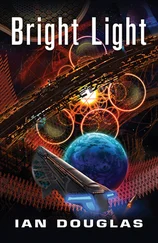The view of the Core Detonation had continued to grow and change as they talked. The scene now appeared to be centered on a glowing disk, a pinwheel of light shading from red at the outer rim to an intense, eye-watering violet at the center.
“Is that the Galactic Core?” Garroway asked. The pinwheel, obviously, was an accretion disk. At its center was a tiny void, an emptiness, into which compressed gas and stellar material appeared to be funneling, a large and massive black hole. Dying matter shrieked its death scream in X-rays and the far ultraviolet.
“No,” Socrates told him. “The Core is about 350 light years in that direction.” Garroway sensed the gesture, deeper into an impenetrable haze of blue-white radiance beyond. “This is the Great Annihilator.”
Garroway had heard of it. A black hole, yes … but not, as once had been imagined, the supermassive black hole at the Galaxy’s exact center. The true Galactic Core consisted of a black hole of about two million solar masses, but, until the Core Detonation wavefront reached the vicinity of Earth, there would be no physical evidence pinpointing it from Earth’s vicinity save for the observed movements of core stars, no light, no radiation of any sort.
The Great Annihilator, on the other hand, was a black hole of only about fifteen solar masses, but it was far noisier—as heard from Earth, at any rate—than its far larger brother nearby. Twin shafts of high-energy radiation speared in opposite directions from the poles of its central hub, streams of positrons emerging from the turbulent areas above the black hole’s north and south poles. The interaction of antimatter with normal matter hundreds of light years from the singularity filled the Core with radio noise—the 511?keV screech of positronium annihilating its normal-matter counterpart—electrons. The object had been detected and named “The Great Annihilator” by Earth astronomers millennia ago, but the discovery had only deepened the mystery of the actual nature of the Galactic Core. By measuring the velocities of stars in the Annihilator’s immediate vicinity, astronomers had proven that it was a black hole, but not the far more massive one at the exact center that they’d been looking for.
In Garroway’s day, of course, it had been well understood that the Xul Dyson cloud had been masking the radiation leakage from the actual Core, and would continue to do so until the Core Detonation crawled out into the Galactic suburbs and impinged upon waiting detectors and sense organs. The Great Annihilator, though, had become a footnote to Galactic cosmography, a little-brother satellite of the larger, better known singularity at GalCenter.
The Core Detonation would have swallowed the Great Annihilator centuries ago. Evidently, the object had not been destroyed, as might have been expected. Clouds of dust and gas sweeping out from the Core explosions had spiraled into the Annihilator’s accretion disk, which glowed now as brightly as a supernova. So much matter continued to fall into the singularity itself that vast quantities, instead of being swallowed, were flung outward as radiant plasmas, and the radio shriek of annihilating matter was far louder now than it had been twelve hundred years before. Garroway could hear that shriek overlaid upon the visual image. Inset windows gave scrolling blocks of data describing the energies exploding from the brilliant object. Radiation levels, he noticed, were high enough to instantly fry any organic matter.
He watched the glowing object for a moment. Through filters raised by the software controlling the imagery, he could actually see the movement of the inner edge of the accretion disk as it whipped across the singularity’s event horizon.
“We have detected signals emerging as nonlocal events from within the Great Annihilator,” Schilling told him. “The physics are … difficult. Suffice to say that phase-shifted habitats may have been inserted into the black hole’s ergosphere.”
“Are you telling me,” he said slowly, “that there’s something alive inside that Hell?”
“Something, yes,” Socrates said. “The Xul, or a part of them. And they’re using their base within the Great Annihilator to attack us.”
“Inside a black hole?”
“Within the ergosphere, yes.”
“That’s impossible,” Garroway said, shaking his head. “ Nothing can escape a black hole’s gravitational field if it gets too close, not even light. That’s part of the thing’s definition.”
“You’re aware of phase shifting, aren’t you, sir?” Schilling asked.
“Yes. We have … sorry, had bases and ships back in my day that could rotate out of phase with four-dimensional spacetime. They existed at the base state of Reality, what we called the Quantum Sea.”
“The Xul apparently can do that as well,” Socrates said, “and from the Quantum Sea, it’s possible to manipulate gravity.”
“The quantum converters?” Schilling added. “The devices we use to provide microsuns for our terraform projects in the Kuiper Belt and beyond? We phase-shift those into the Quantum Sea, where they can draw as much energy as we need directly from the Reality base state. The Xul are doing something similar inside the Great Annihilator.”
“What?”
“We’re not sure,” Socrates said. “It’s possible that they hope to affect the entirety of the Reality base state … to, in effect, rewrite what we’re pleased to think of as reality.”
“Editing us out of existence?”
“It’s a possibility. That, at least, is one of the scenarios our Xul iteration programs have developed. But it’s also possible that they’re using singularity-identity nonlocality to infect our AI and computer networks with alien emomemes.”
“Whoa,” Garroway said. “You just lost me … about eight hundred years ago.”
“Singularity-identity nonlocality?” Schilling asked. Garroway nodded.
“The theory can be a bit murky,” Socrates told him. “Do you know how stargates work?”
“Not the technical details, but yes,” Garroway said. “In principle, at least.”
Stargates were immense artifacts scattered across the Galaxy and beyond, ten- to twenty-kilometer-wide rings within which pairs of planetary-mass black holes revolved in opposite directions. The interplay of moving gravitational fields opened direct links between one gate and another, light years distant, with which it was tuned. Exactly who had built them, or when, was a mystery, but stargates were still the principal means of long-range travel throughout the Galaxy.
“Stargates work,” Socrates told him, “because the movement of singularities within two stargates can be tuned to one another so that they essentially become congruent, a fancy way of saying they are the same. Identical. The same gate, but located in two widely separated places at once … orbiting Sirius, say, and the Galactic Core. The theory depends on quantum states and an aspect of quantum dynamics called nonlocality, which says that two objects or particles entangled at the quantum level remain connected to one another, as though there was no space, no distance, between them.”
“I know about that one,” Garroway said. “Albert Einstein called it ‘spooky action at a distance,’ and refused to accept that it described the universe realistically.”
“Albert … who?” Schilling asked.
“Einstein,” Socrates told her. “A pre-spaceflight philosopher.”
“Physicist, actually,” Garroway said. “At least according to the history downloads I’ve seen.”
“Physicist, then,” Socrates agreed, “though physicists and philosophers are much the same thing when it comes to describing aspects of the metaverse that can only indirectly be apprehended, and which can only be described by myth and metaphor. In any case … if you have access to base-state reality in one black hole, you theoretically have direct access to all black holes … and to the star gates as well, since they depend on artificial singularities for their operation.”
Читать дальше












